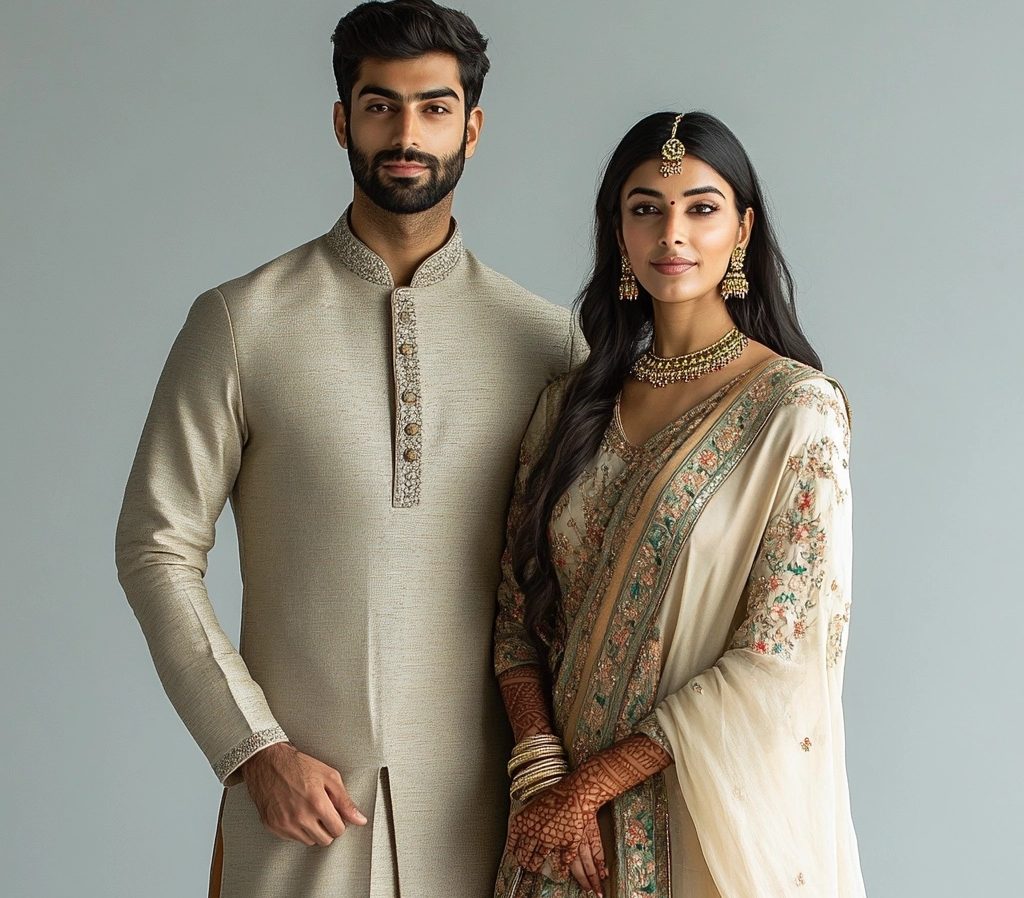
Finding the right Indian dress can be overwhelming.
With countless styles, patterns, and regional variations, many people struggle to understand the differences between various Indian outfits and when to wear them.
Here’s good news: you can easily learn about the most-worn Indian dresses and make smart choices for different occasions.
This guide breaks down 21 essential Indian dress styles that belong in your wardrobe.
In this article, you’ll learn what makes each dress unique, the best occasions to wear them, and practical tips to style them.
From everyday wear to wedding attire, we’ll walk through the key details of India’s cherished clothing traditions.
Iconic Indian Dresses for Every Occasion
Women’s Indian Dresses
1. Saree
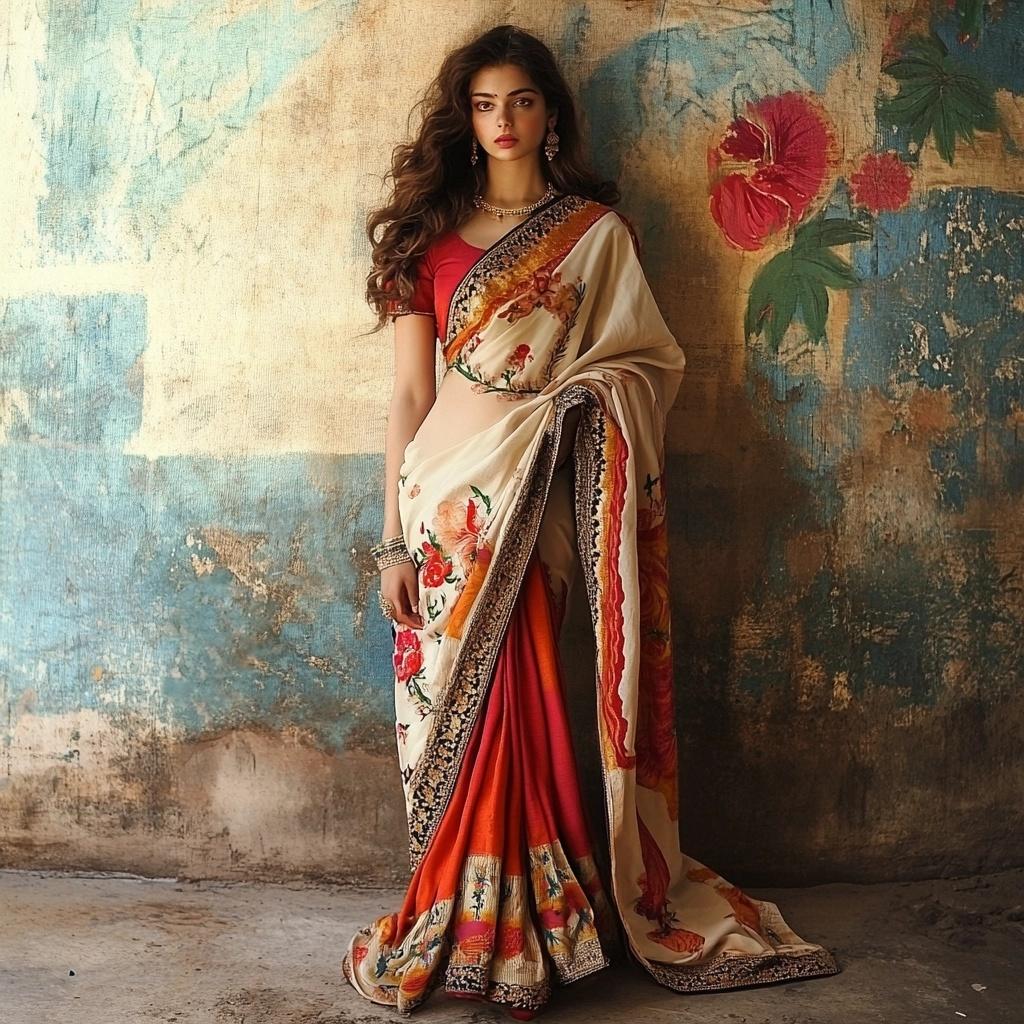
A saree is a flowing garment made from a single cloth piece, typically 5-9 yards long. The fabric wraps around the body, with one end draped over the shoulder.
- Style Tips: Choose pleats based on your height – thinner pleats for shorter frames, wider for taller frames. Pin the pallu (shoulder drape) neatly for a clean look. Pick blouse designs that match your comfort level.
- Where to Wear: Perfect for formal events, festivals, weddings, office wear, and daily use, depending on the fabric and work details.
- Jewelry Pairing: Layer necklaces of different lengths, add bangles that match the saree border, wear statement earrings, and use a waistbelt for structure.
2. Lehenga Choli
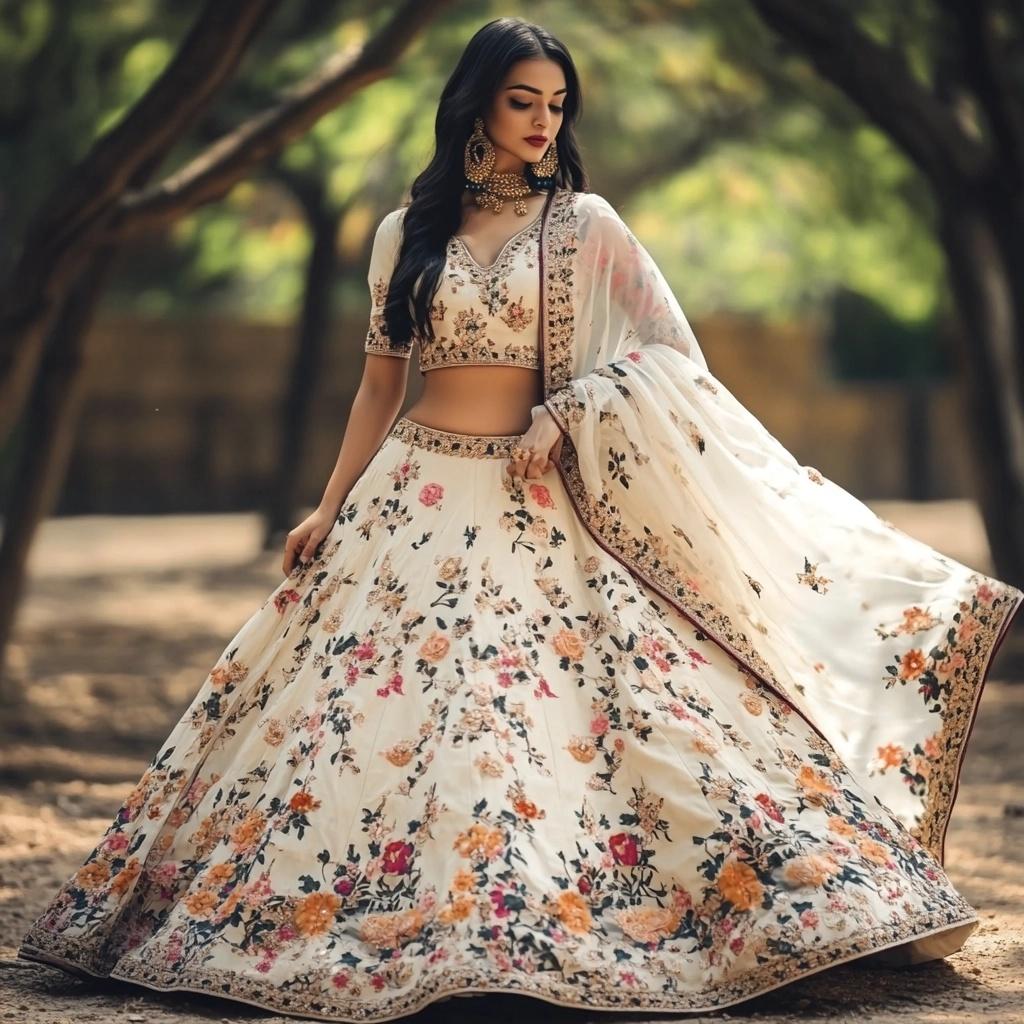
A three-piece outfit consisting of a long skirt (lehenga), fitted blouse (choli), and a scarf (dupatta). The skirt features wide circular cuts that create beautiful movement, while the blouse highlights the traditional Indian design elements.
- Style Tips: Match the dupatta draping with your body type – crossed for petite frames, single shoulder for tall frames. Keep the blouse fit comfortable for easy movement.
- Where to Wear: Ideal for weddings, festive celebrations, engagement ceremonies, and special cultural events.
- Jewelry Pairing: Choose statement necklaces, wear traditional maang tikka, add matching bangles, and use long earrings to complete the look.
3. Salwar Kameez
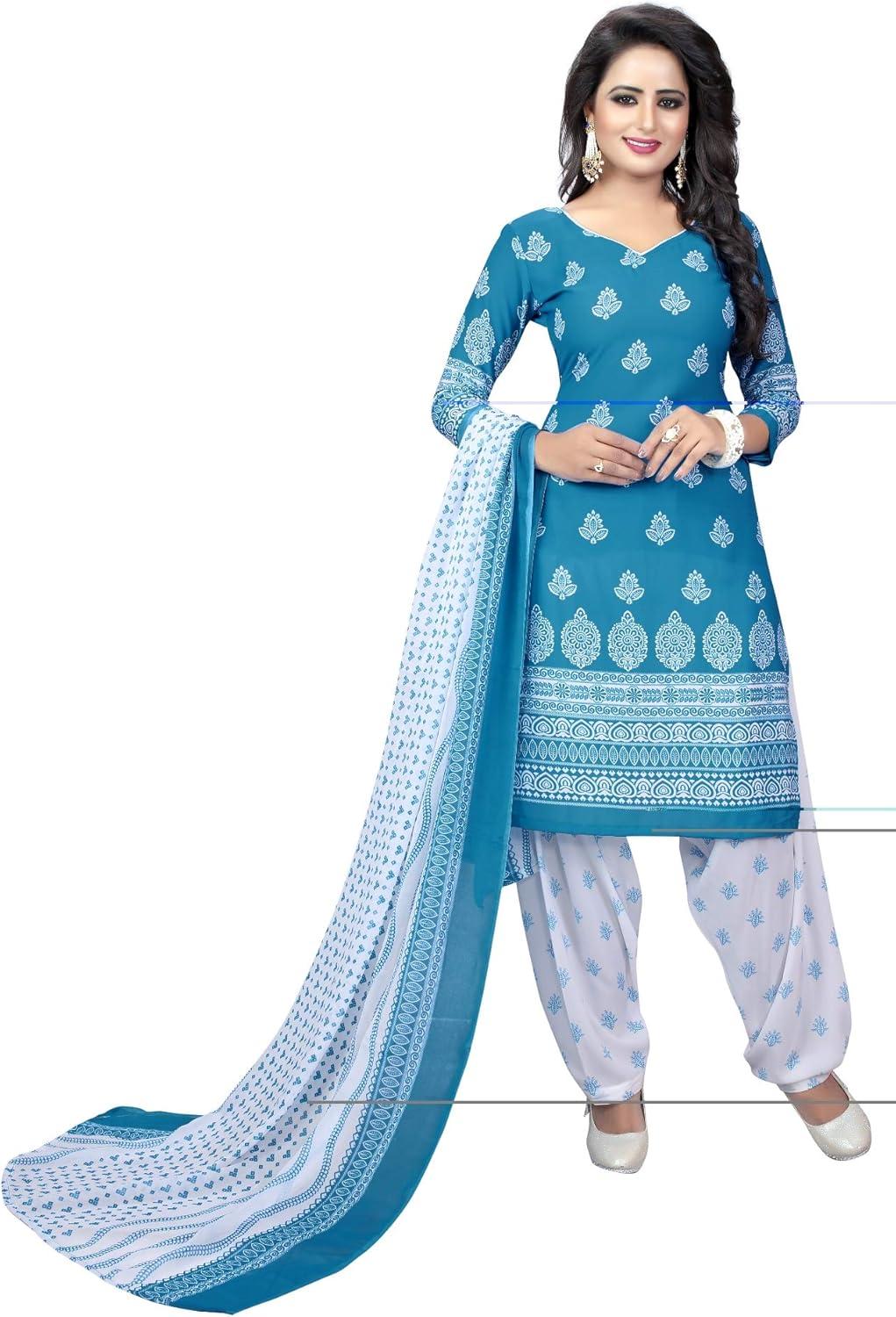
A versatile three-piece ensemble with a long tunic (kameez), loose or fitted pants (salwar), and a matching scarf (dupatta). This outfit offers comfort while maintaining a graceful appearance.
- Style Tips: Pick a kameez length that suits your height – knee-length for shorter frames, longer for taller frames. Match the salwar style to your body type.
- Where to Wear: Suitable for daily wear, office settings, casual gatherings, religious events, and semi-formal occasions.
- Jewelry Pairing: Use simple chain necklaces, wear stud earrings for daily wear, add thin bangles, and choose practical jewelry for regular use.
4. Anarkali Suit
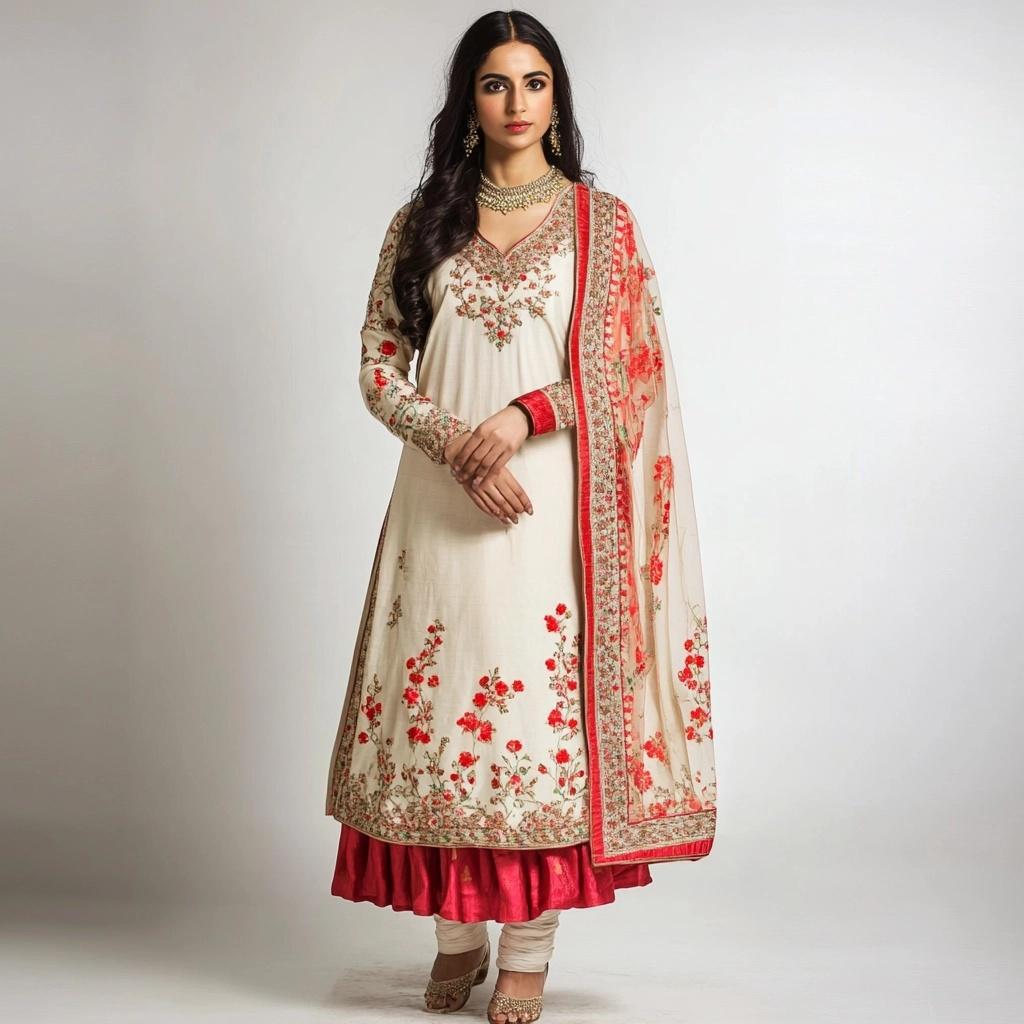
Named after a famous court dancer, this outfit features a long frock-style top with a fitted bodice and flowing bottom that extends into a full circle. The suit pairs with fitted pants and a matching scarf, creating a regal silhouette that flatters various body types.
- Style Tips: Select a length based on height – calf-length for shorter frames, floor-length for taller frames. Focus on empire waist cuts for a balanced look.
- Where to Wear: Perfect for receptions, cultural events, parties, special occasions, and formal gatherings.
- Jewelry Pairing: Pick medium-length necklaces, wear drop earrings, add thin bangles, and use minimal rings for balance.
5. Silk Saree
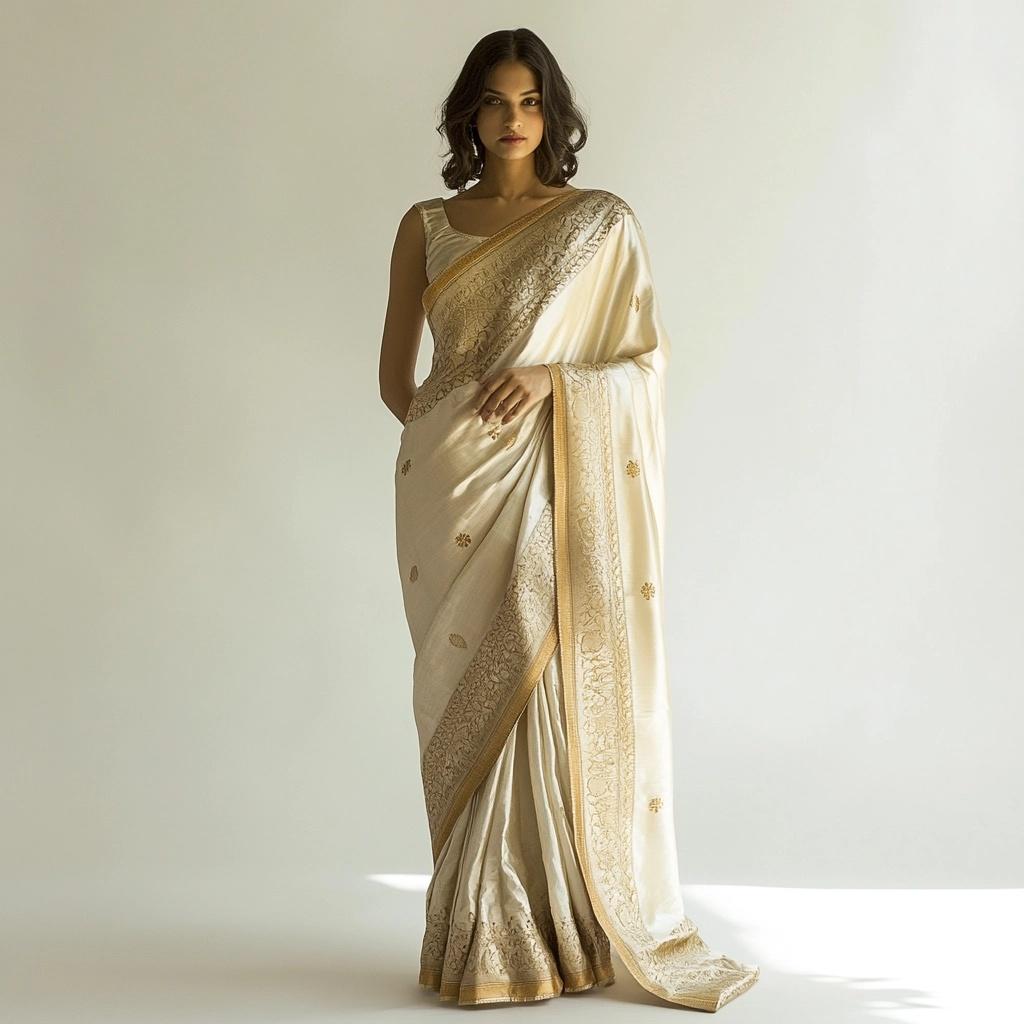
Known for their shine and smooth texture, silk sarees offer both comfort and style. These versatile sarees range from plain designs to detailed work, suitable for various occasions.
- Style Tips: Use soft pleats for natural flow. Pin the pallu carefully to maintain shape. Select contrasting blouse designs for visual interest.
- Where to Wear: Suitable for family functions, office events, religious ceremonies, and semi-formal occasions.
- Jewelry Pairing: Mix gold and pearl jewelry, wear simple chains, add classic bangles, and choose subtle earrings.
6. Churidar Suit
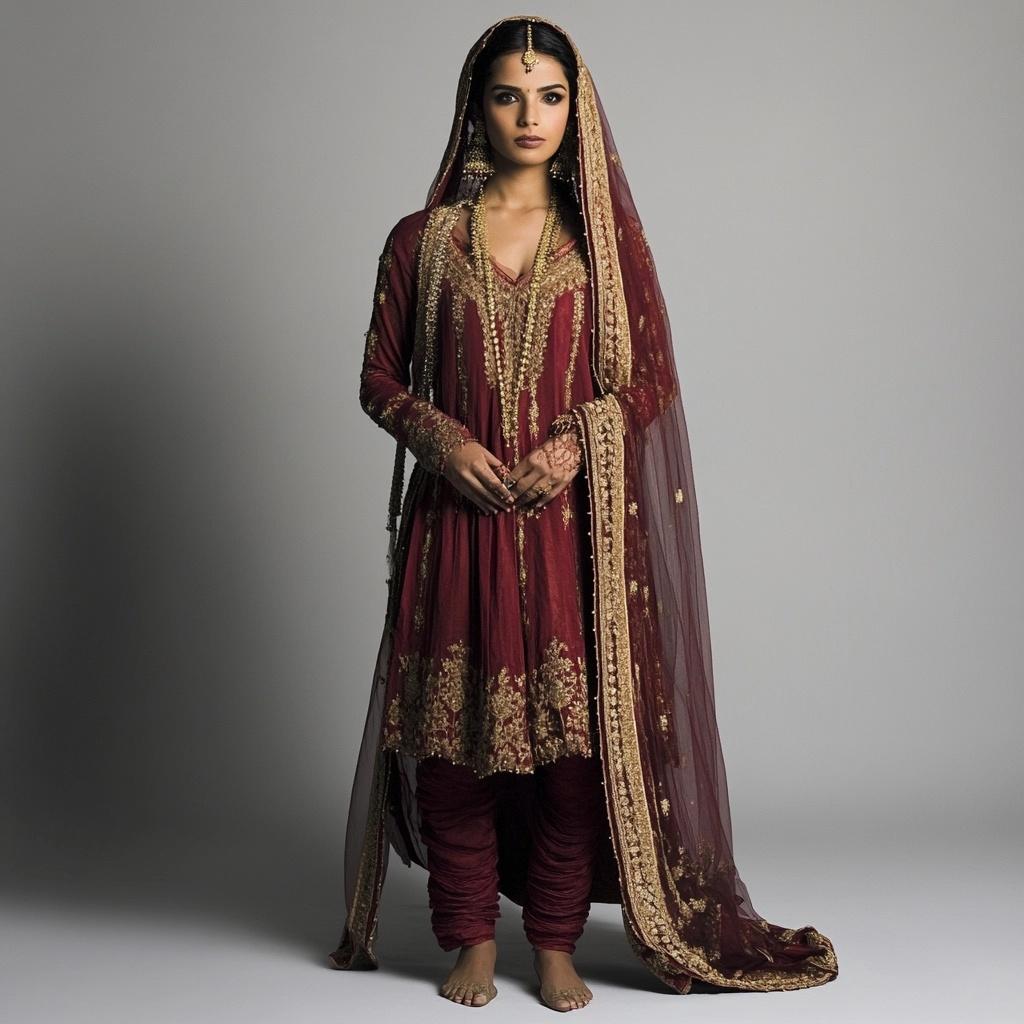
This outfit features a knee-length or longer top paired with tight-fitting pants that gather at the ankles in subtle folds. The slim silhouette creates a modern, sophisticated look.
- Style Tips: Choose a straight-cut top for a slim look. Keep the pants’ length slightly longer for proper ankle gathering. Use the dupatta as a light accent.
- Where to Wear: Excellent for office wear, casual meetings, daily outings, small functions, and regular use.
- Jewelry Pairing: For a clean look, select simple pendants, wear small earrings, add thin bangles, and use minimal accessories.
7. Patiala Suit
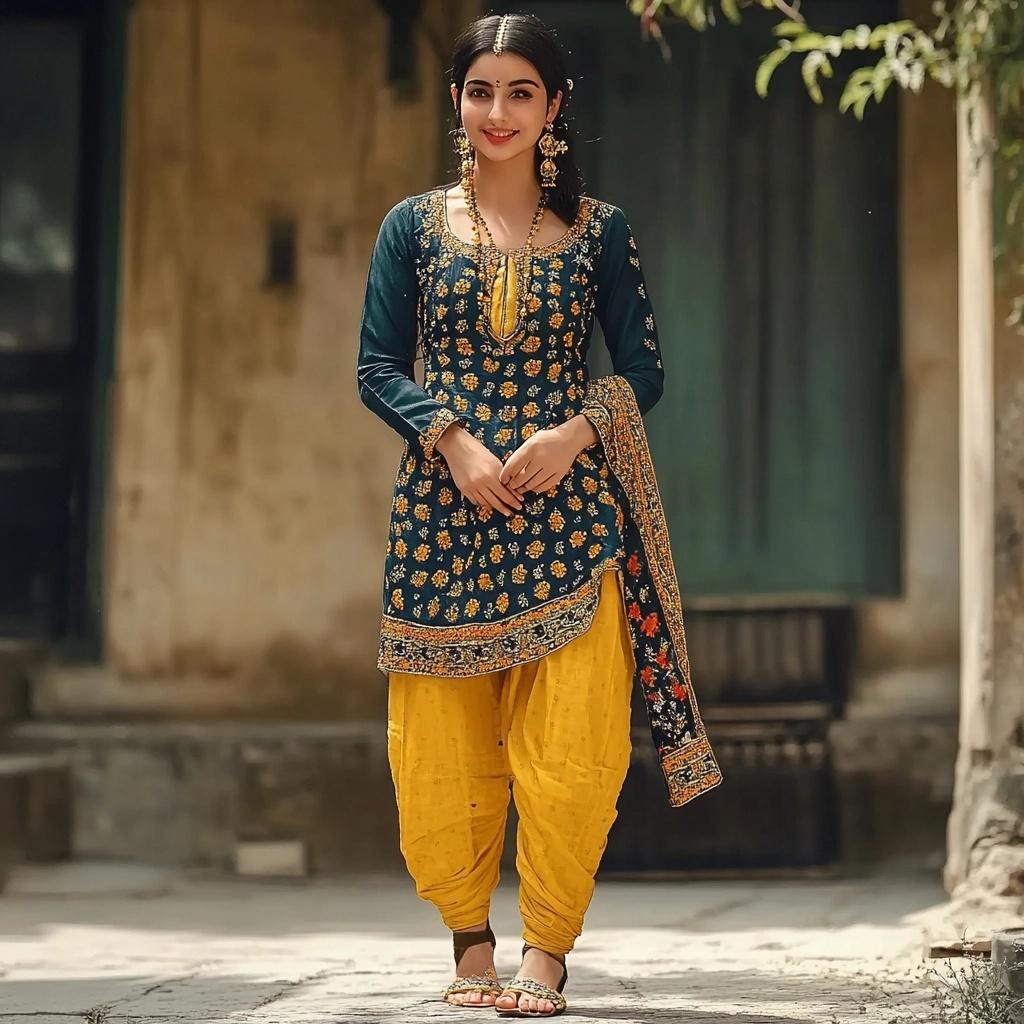
Known for its extra-wide pleated pants, this Punjabi outfit pairs loose, comfortable bottoms with a medium-length top and scarf. The pants feature multiple pleats that create a unique, flowing effect.
- Style Tips: Keep the top fitted to balance the wide pants. Fold the pants properly to maintain pleats. Use the dupatta to add structure.
- Where to Wear: Suited for college wear, casual outings, home functions, comfortable daily wear, and informal gatherings.
- Jewelry Pairing: Choose simple studs, wear light chains, add colorful bangles, and use practical accessories for daily use.
8. Banarasi Saree
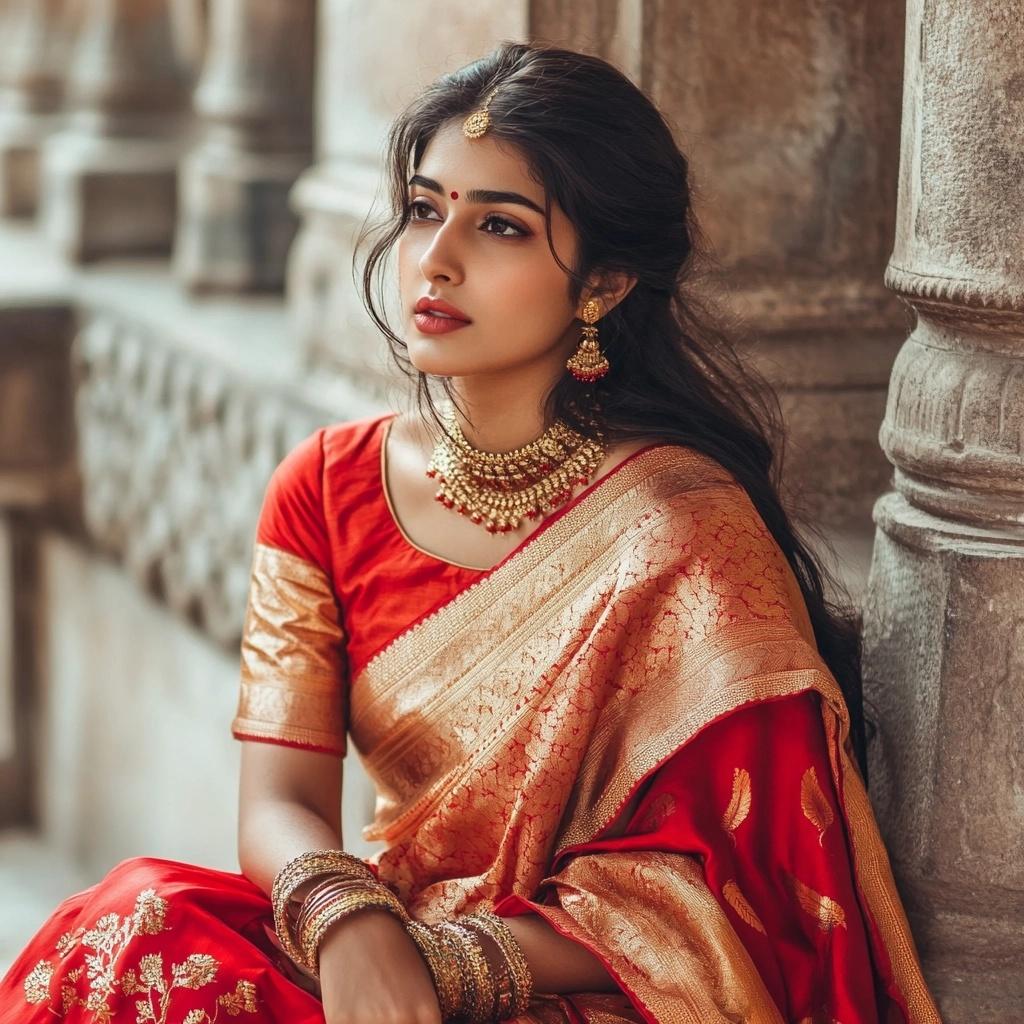
Originating from Varanasi, these sarees showcase intricate silk weaving with rich gold and silver threads (zari). The detailed motifs often feature floral patterns, leaves, and geometric designs woven throughout the fabric, making each piece unique.
- Style Tips: Drape with neat pleats to show the border design. Keep the pallu length medium to display the rich work. Select blouse designs that complement but don’t overshadow the saree patterns.
- Where to Wear: Best suited for weddings, important festivals, significant ceremonies, and major family events.
- Jewelry Pairing: Traditional gold necklaces, temple jewelry, pearl combinations, and matching bangles enhance the classic look.
9. Tunic Dress
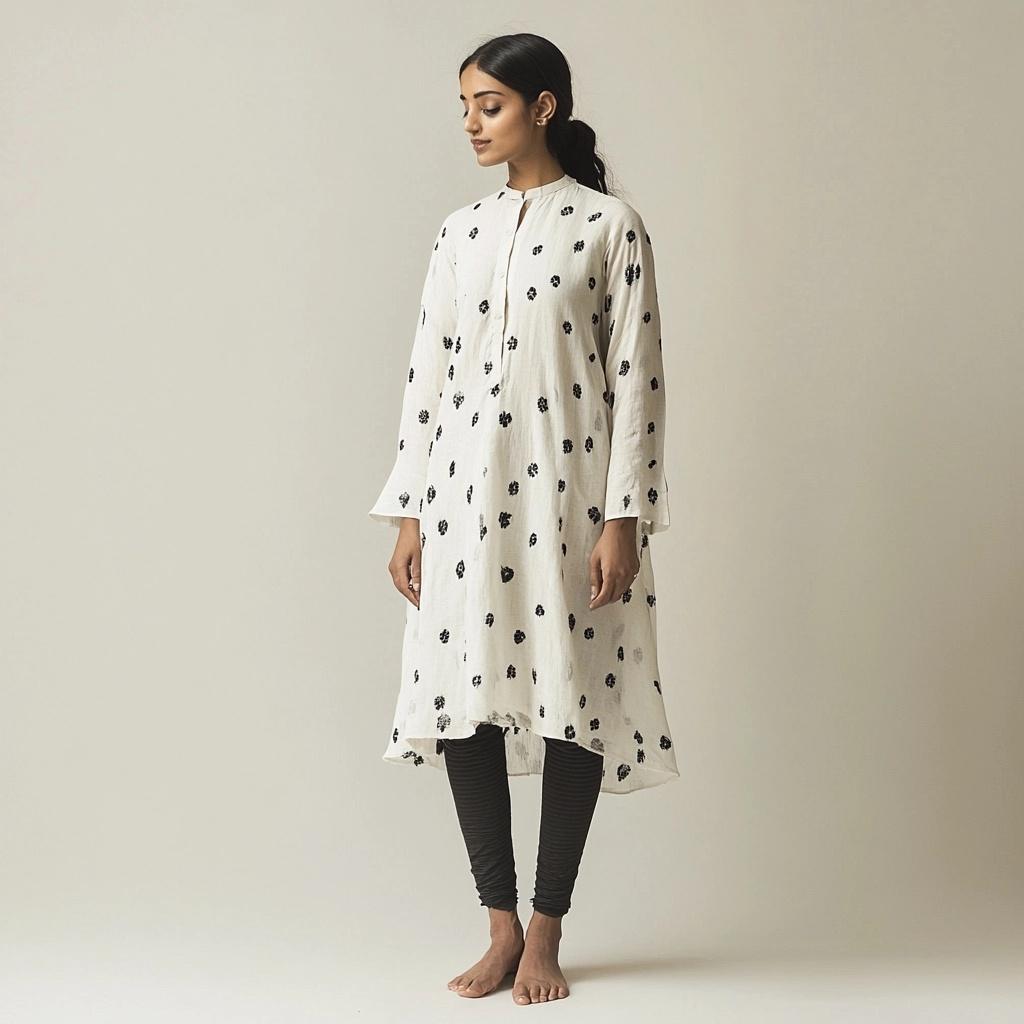
A fusion wear piece combining Indian and Western elements. The straight-cut dress often includes Indian prints, embroidery, or traditional design elements while maintaining a modern silhouette.
- Style Tips: Choose length based on comfort level. Add Indian prints for cultural touch. Pair with pants or wear solo based on occasion.
- Where to Wear: Great for casual meetings, lunch dates, shopping trips, and informal gatherings.
- Jewelry Pairing: Modern pendants, short earrings, slim bracelets, and minimal rings suit the style.
10. Sharara Suit
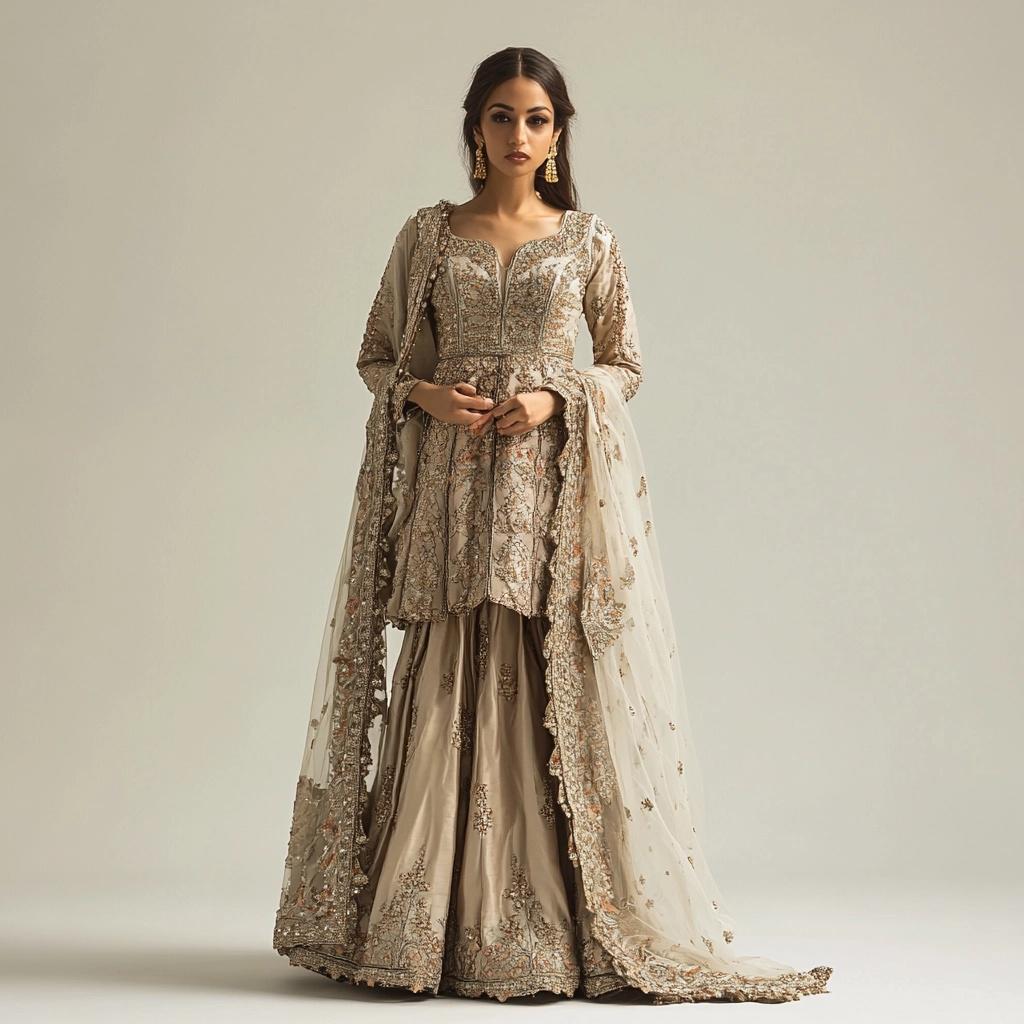
An outfit with a fitted top paired with wide-legged pants that flare dramatically from the knees down. The style creates a graceful silhouette with movement.
- Style Tips: Balance the top length with the pants’ flare. Keep the dupatta light to maintain proportion. Choose complementary colors for all pieces.
- Where to Wear: Great for engagement parties, reception events, formal gatherings, and special occasions.
- Fabric Choices: Georgette for flow, crepe for structure, silk for richness, net for volume.
- Jewelry Pairing: Long earrings, layered necklaces, statement rings, and matching bangles enhance the look.
11. Chaniya Choli
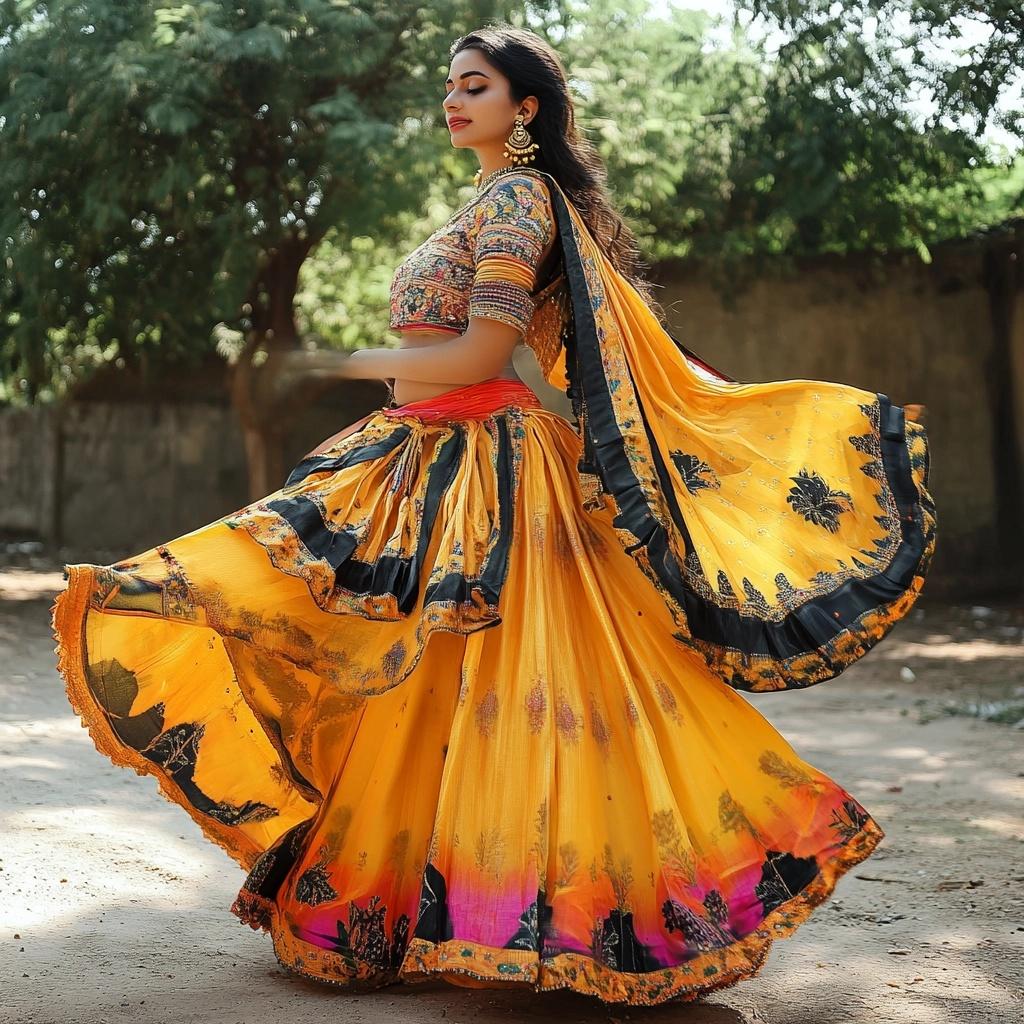
A Gujarati traditional outfit featuring a flared skirt, short blouse, and decorated scarf. The outfit often includes mirror work, bright colors, and traditional prints.
- Style Tips: Match the blouse length to your comfort. Keep the skirt flare according to use. Style the dupatta in various ways for different looks.
- Where to Wear: Made for Garba nights, Gujarati festivals, traditional celebrations, and cultural performances.
- Fabric Choices: Cotton for practice, satin for shine, silk for events, crepe for flow.
- Jewelry Pairing: Oxidized jewelry, colorful bangles, traditional Gujarati pieces, and anklets complete the look.
12. Kurtis
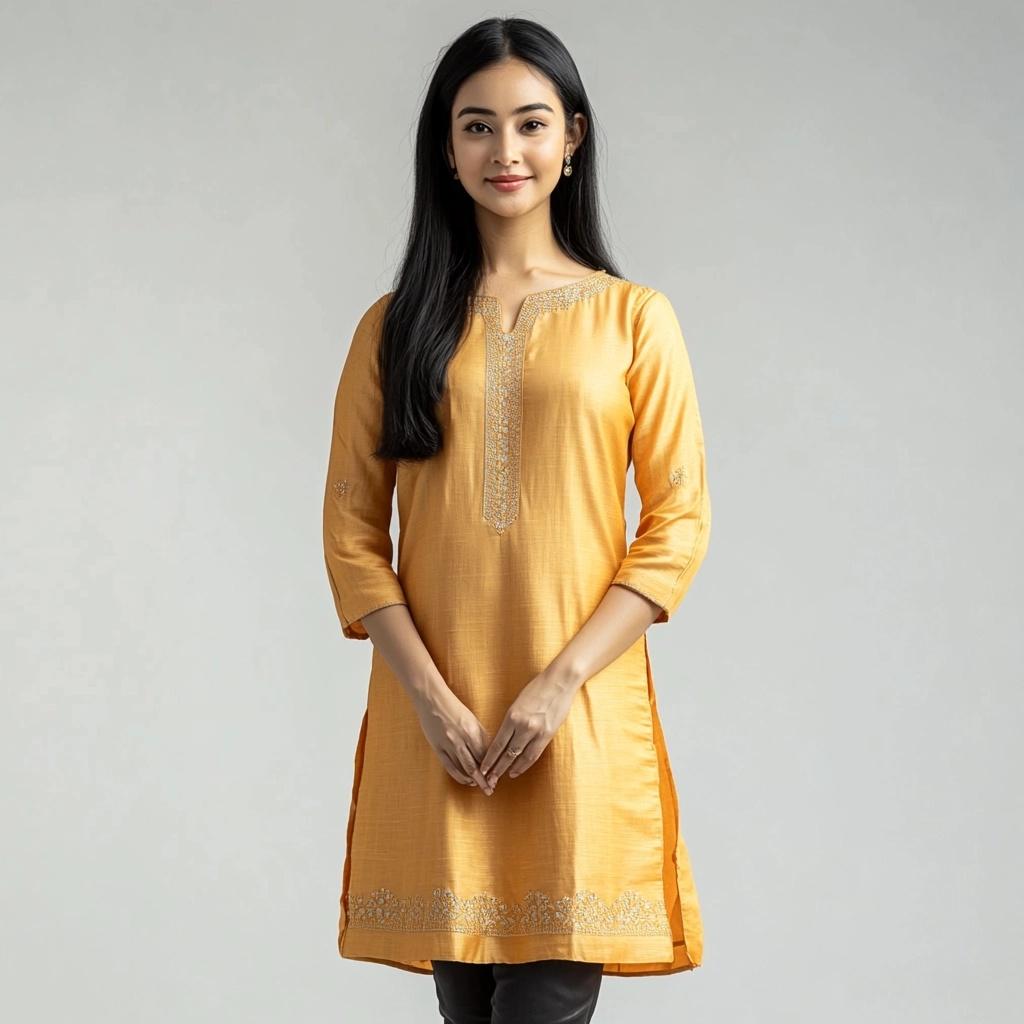
A versatile top that varies in length from hip to knee-length, combining traditional Indian elements with modern cuts. This adaptable garment works well with different bottom styles and suits multiple body types.
- Style Tips: Pick length based on your height and bottom style. Add side slits for easy movement. Mix patterns with solid bottoms for balance.
- Where to Wear: Fits perfectly for college, office, casual outings, shopping trips, and daily activities.
- Jewelry Pairing: Small pendant sets, stud earrings, simple bracelets, and basic watches suit daily wear.
13. Pavadai Daavani
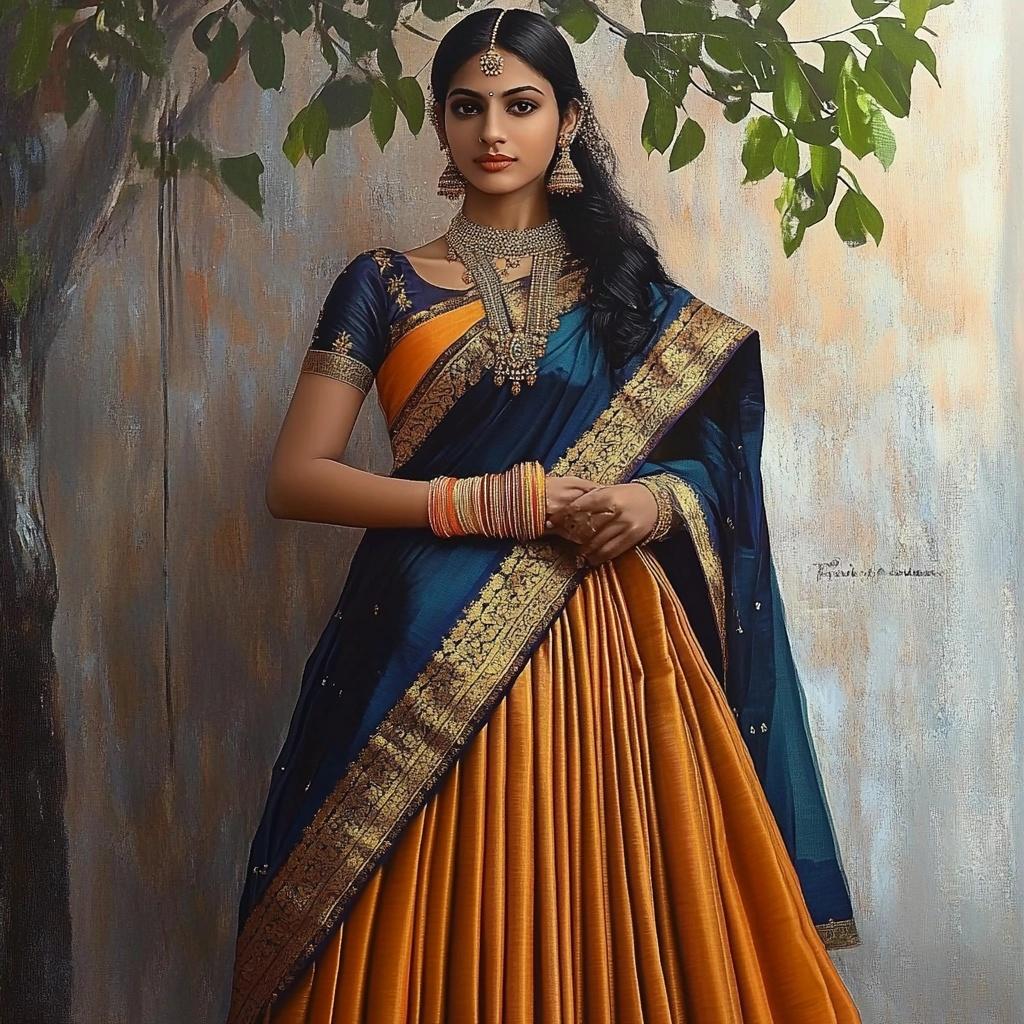
A traditional South Indian girls’ outfit consisting of a long skirt, blouse, and shawl. This three-piece ensemble represents the transition wear between childhood and adult clothing, often featuring contrasting colors and simple patterns.
- Style Tips: Match skirt and shawl colors while using contrast blouse. Keep the skirt length ankle-level for comfort. Drape the shawl neatly across the chest.
- Where to Wear: Popular for cultural events, temple visits, small ceremonies, and traditional dance performances.
- Jewelry Pairing: Simple chains, small earrings, thin bangles, and traditional South Indian jewelry suit well.
14. Leheriya Saree
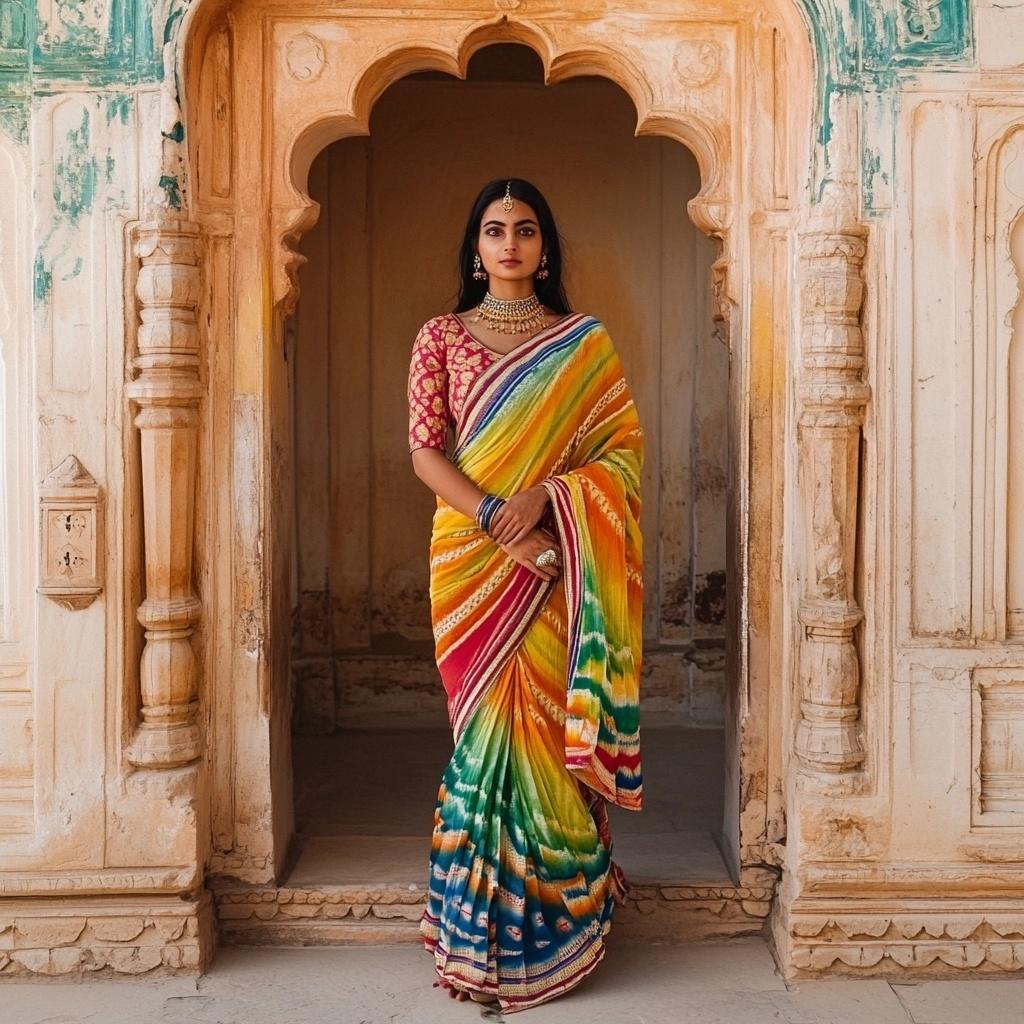
A Rajasthani tie-dye technique creates diagonal stripes in various colors. The pattern resembles waves, offering a fresh take on traditional saree designs.
- Style Tips: Align the diagonal lines while pleating. Keep blouse designs simple. Use the pallu to show the pattern’s full effect.
- Where to Wear: Perfect for summer events, casual functions, regional festivals, and daily wear.
- Jewelry Pairing: Silver jewelry, colored stone sets, light necklaces, and simple bangles complement well.
Men’s Indian Dresses
15. Kurta Pajama
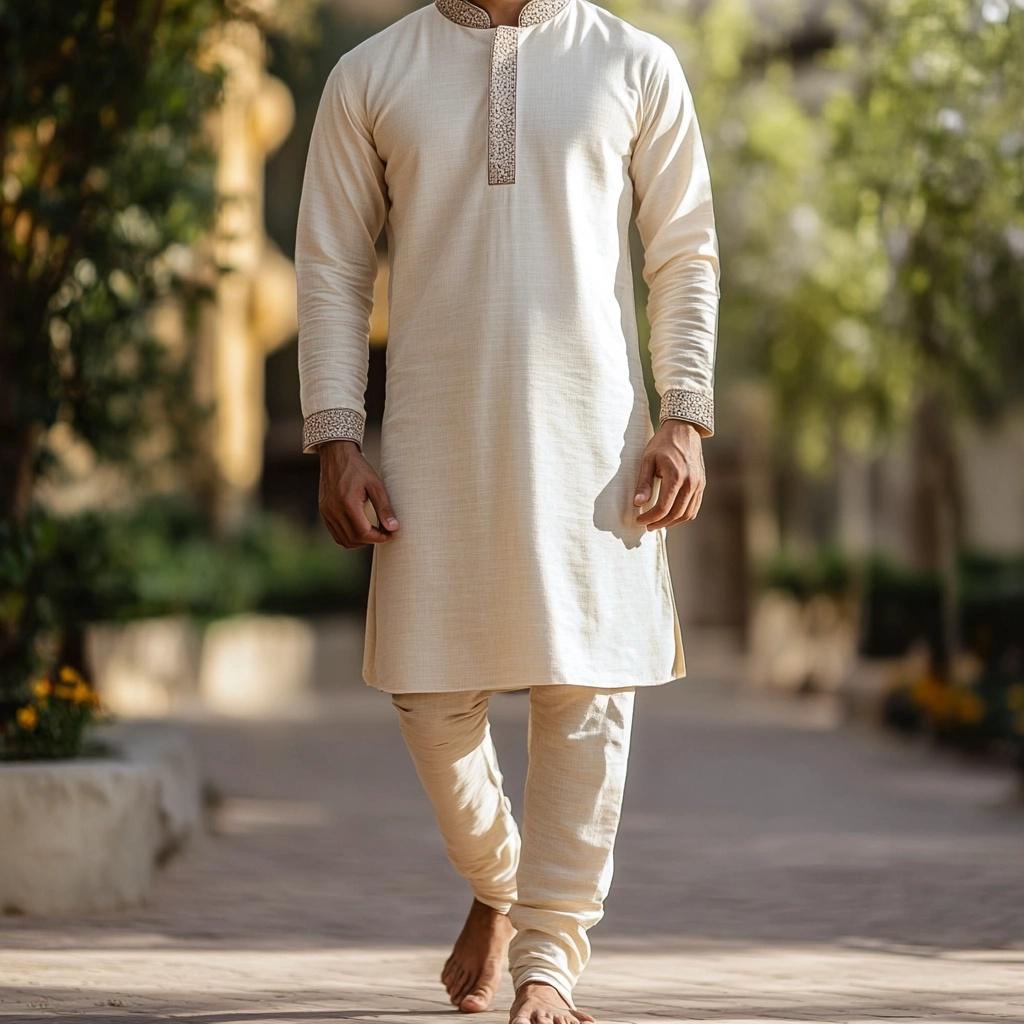
A classic men’s outfit combining a long tunic (kurta) with loose-fitting trousers (pajama). This comfortable and simple combination ranges from basic daily wear to detailed formal styles.
- Style Tips: Choose kurta length based on height – knee-length for shorter frames, longer for taller frames. Keep pajama fit relaxed but not baggy.
- Where to Wear: Suitable for daily use, office settings with ethnic wear policy, religious functions, casual gatherings, and semi-formal events.
- Styling Add-ons: Nehru jackets for a formal touch, stoles for winter, mojari shoes for a traditional look, and watches for a modern touch.
16. Sherwani
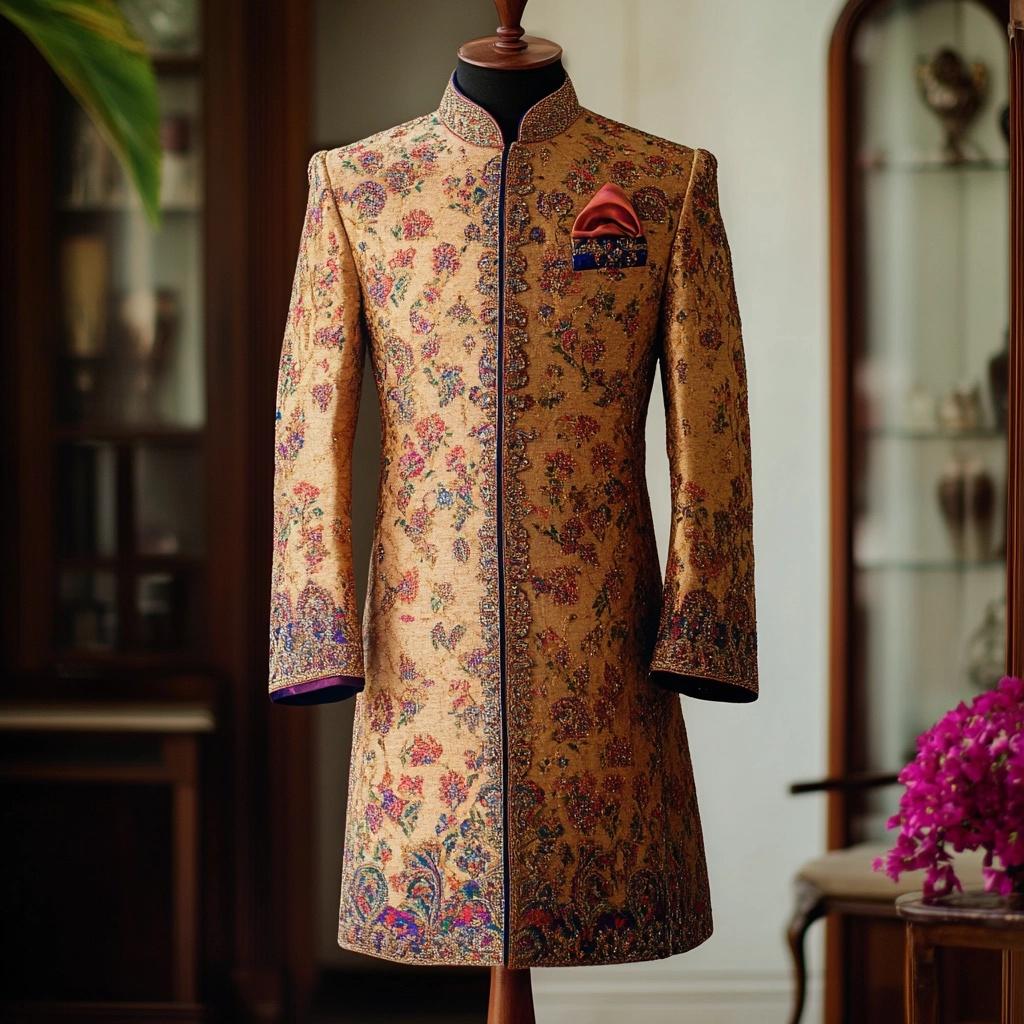
A long coat-like garment that extends to the knees or below, featuring detailed embroidery and button work. This formal attire creates a distinguished, refined appearance.
- Style Tips: Ensure a perfect shoulder fit. Match the bottom wear color with embroidery details. Keep the length proportional to height.
- Where to Wear: Made for weddings, formal ceremonies, important cultural events, and high-profile gatherings.
- Styling Add-ons: Silk stoles, brooch pins, traditional buttons, and formal shoes enhance the look.
17. Dhoti
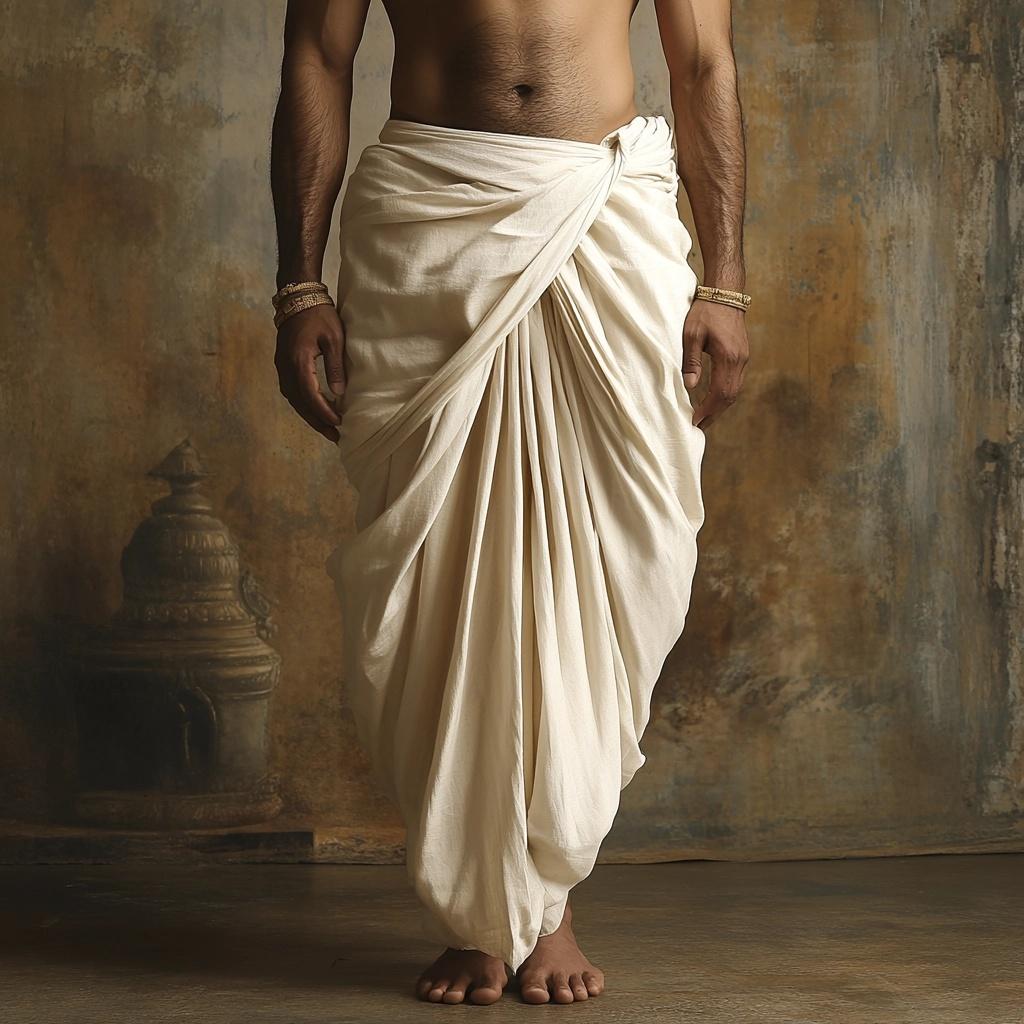
A traditional unstitched garment wrapped around the waist and legs, creating distinctive pleats. This timeless piece represents classical Indian menswear with regional variations.
- Style Tips: Learn the proper pleating technique for your regional style. Keep the length consistent. If needed, add a belt for security.
- Where to Wear: Perfect for religious ceremonies, traditional functions, cultural performances, and regional festivals.
- Styling Add-ons: Upper cloth (angavastram), traditional belt, ethnic sandals, simple jewelry pieces.
18. Angrakha
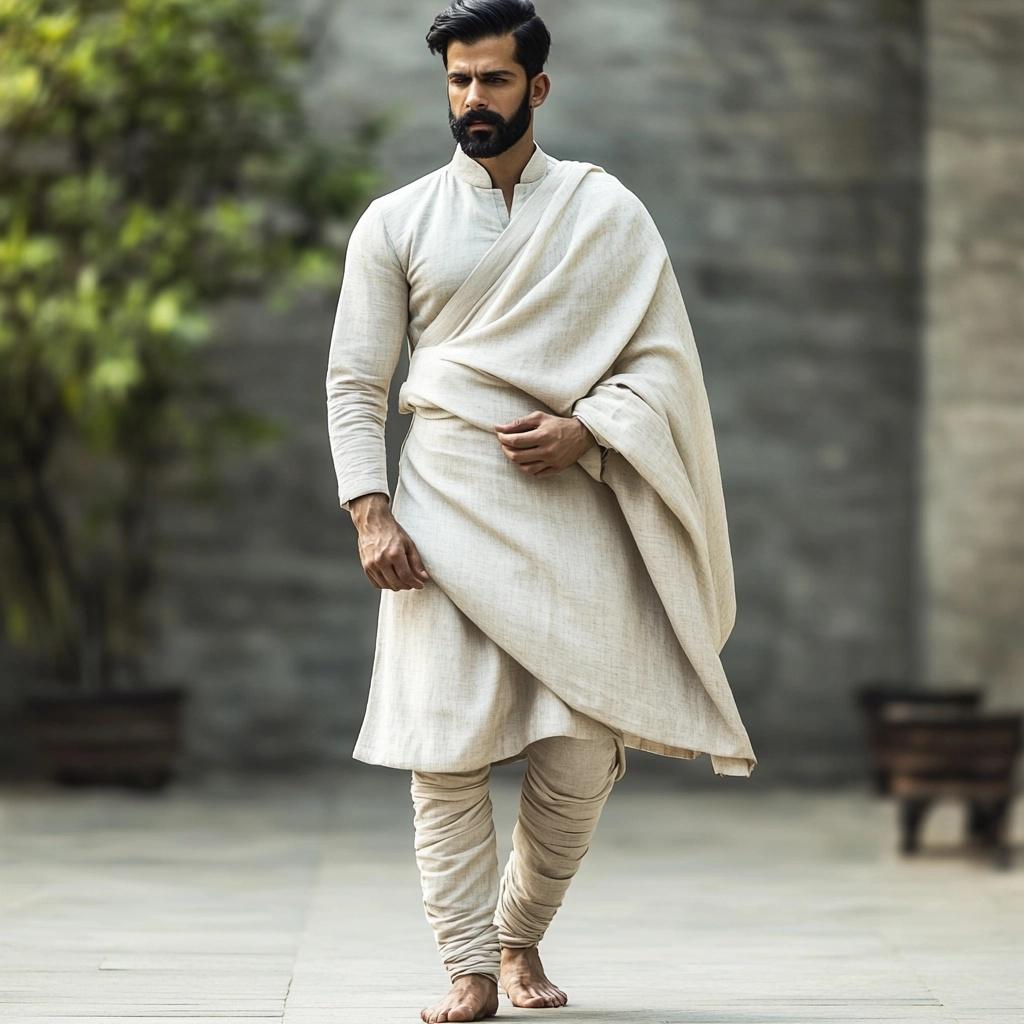
A style featuring an overlapping front panel, typically secured at the sides, creating a distinctive wrap effect. This design offers both comfort and traditional charm.
- Style Tips: Adjust the overlap based on body type. Use proper ties or buttons for secure fit. Match the bottom wear carefully.
- Where to Wear: Ideal for cultural events, music festivals, art shows, and traditional gatherings.
- Styling Add-ons: Traditional belts, ethnic footwear, simple scarves, and basic jewelry enhance the look.
19. Pathani Suit
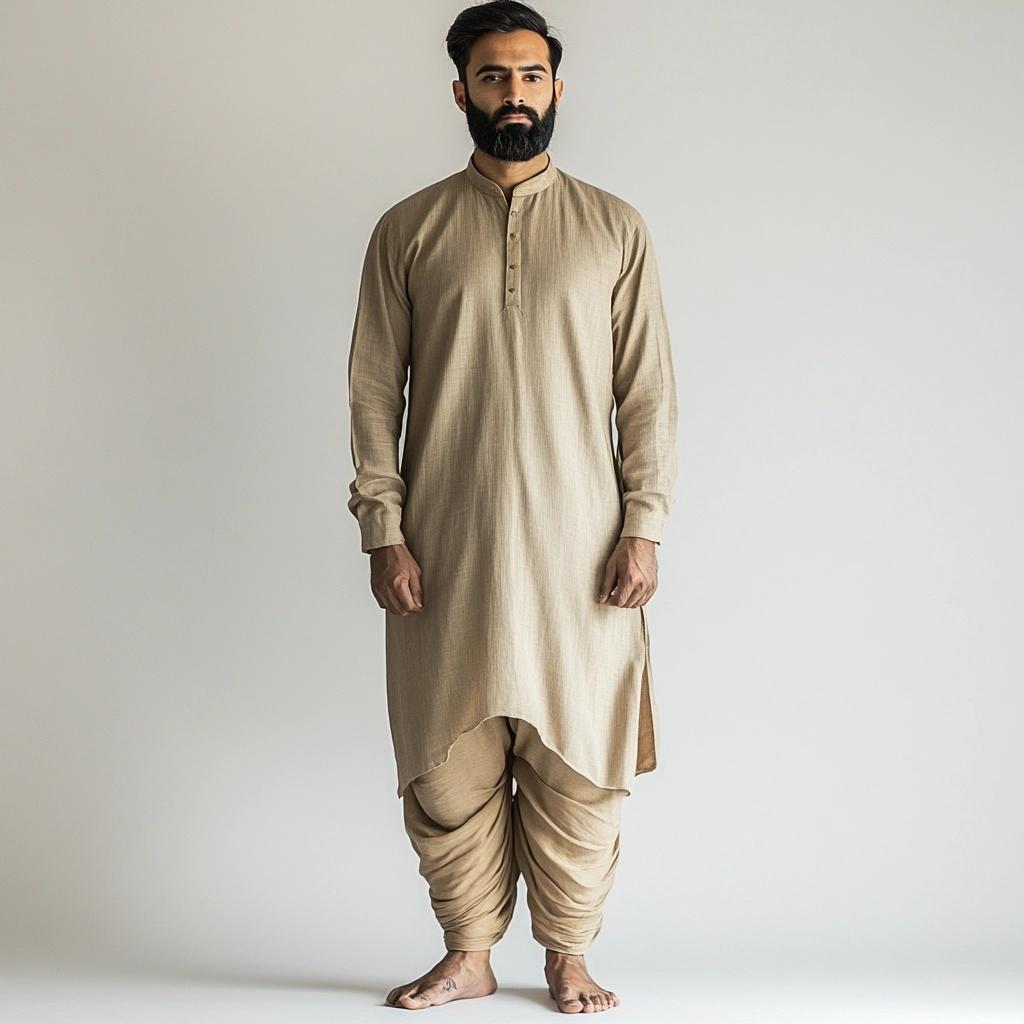
A relaxed-fit ensemble with a long knee-length shirt and loose pants, originating from the Pathan region. The outfit stands out with its distinct collar, full sleeves, and comfortable cut.
- Style Tips: Select a shirt length that ends below the knee. Keep the pants loose but not too wide. Add side pocket details for authenticity.
- Where to Wear: Fits well for Friday prayers, community gatherings, casual meetups, and comfortable daily wear.
- Styling Add-ons: Traditional cap, leather sandals, simple watch, plain stole for winter.
20. Pheran
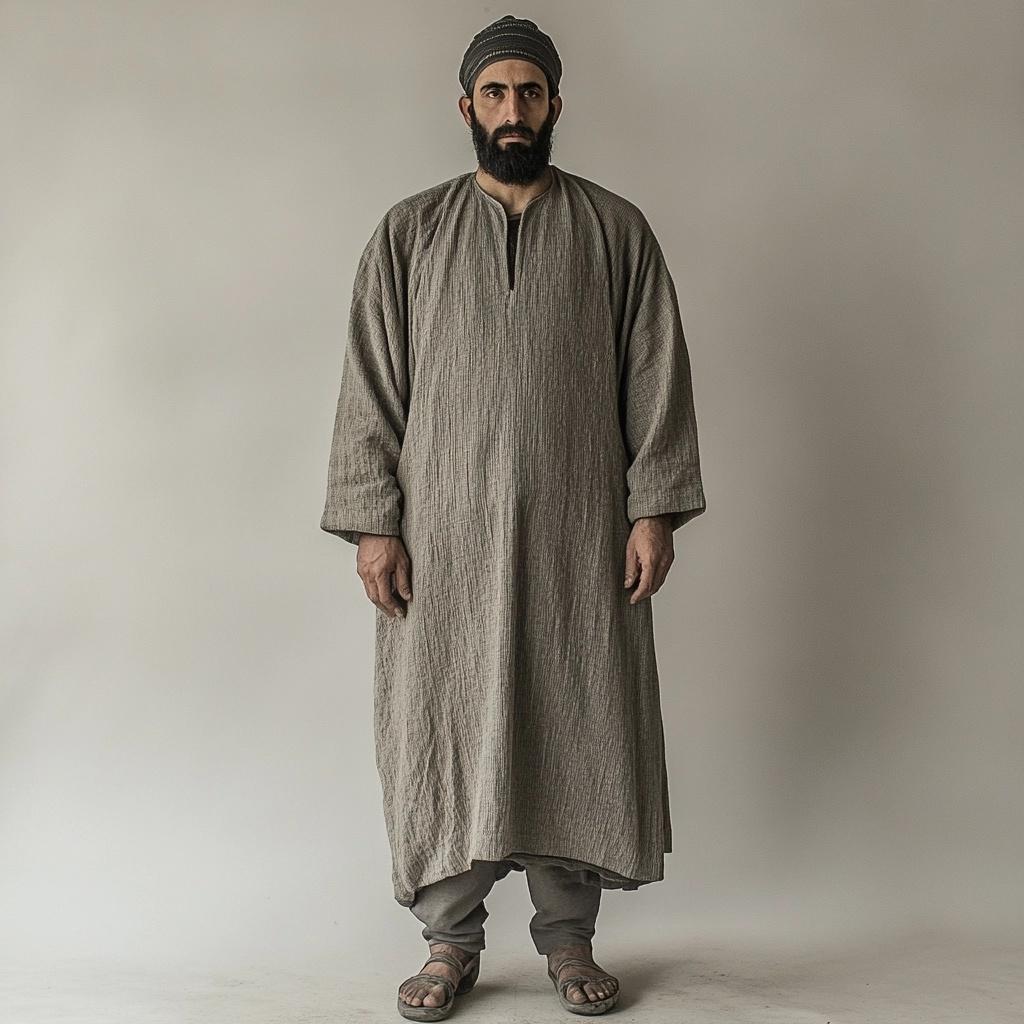
A loose, warm garment from Kashmir that extends below the knees, featuring long sleeves and a high neck. This comfortable outfit provides warmth while maintaining style.
- Style Tips: Layer with inner clothes during winter. Add traditional embroidery for authenticity. Keep length below knees for proper coverage.
- Where to Wear: Perfect for winter occasions, casual outings in cold weather, home wear, and regional celebrations.
- Styling Add-ons: Kashmiri shawl, traditional cap, warm socks, simple scarf.
21. Lungi
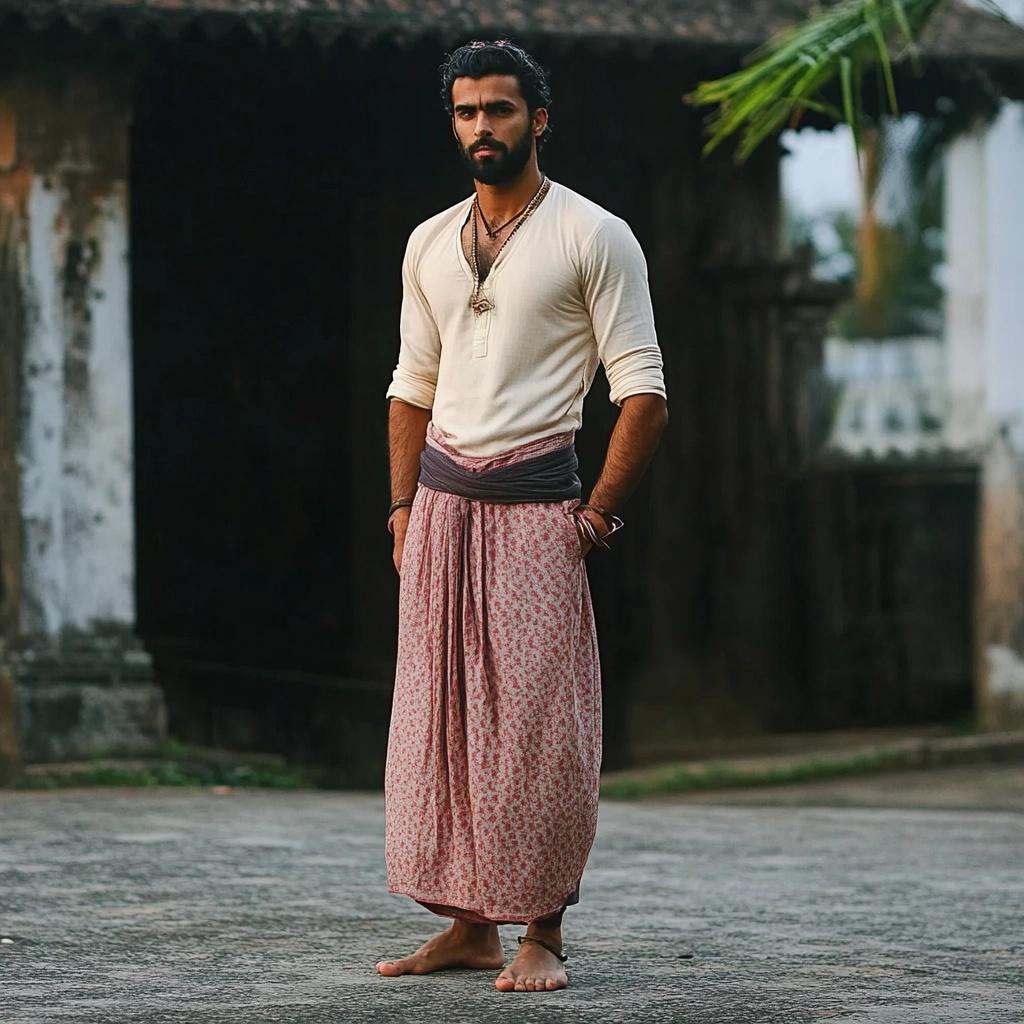
A versatile unstitched garment wrapped around the waist, popular in South India and coastal regions. This practical garment offers comfort in warm weather.
- Style Tips: Learn different folding styles for various occasions. Adjust length based on activity. Keep the pleats neat when folded.
- Where to Wear: Ideal for home wear, casual neighborhood visits, relaxed settings, and warm weather.
- Styling Add-ons: Simple vest or shirt, rubber slippers for casual wear, belt for secure fit.
Conclusion
Indian clothing offers a rich mix of styles, each telling its own cultural story.
From the basic cotton kurta to detailed silk sarees, these outfits suit different occasions and personal preferences.
By understanding these 21 traditional styles, you can make informed choices for various events and celebrations.
Remember, the key to wearing Indian clothes lies in choosing the right fabric, understanding the occasion, and pairing proper accessories.
Whether you’re selecting your first saree or adding to your collection of regional wear, these traditional designs offer options for everyone.
Ready to try these styles? Start with simple, comfortable pieces and gradually add detailed items to your wardrobe.
Share your experiences with these traditional outfits in the comments below.

